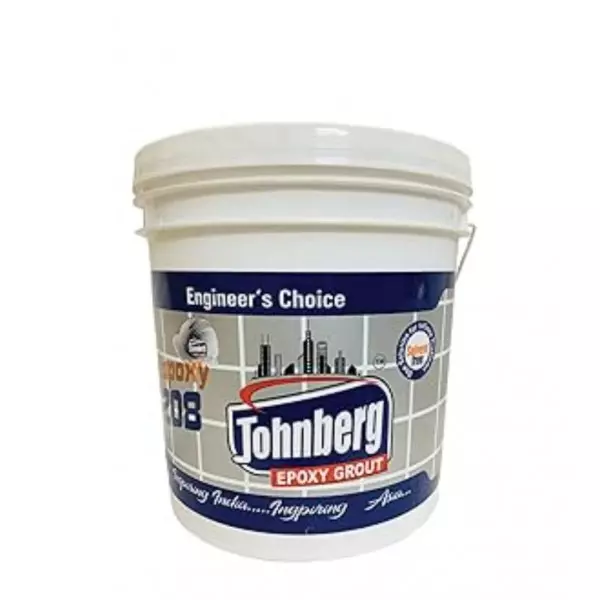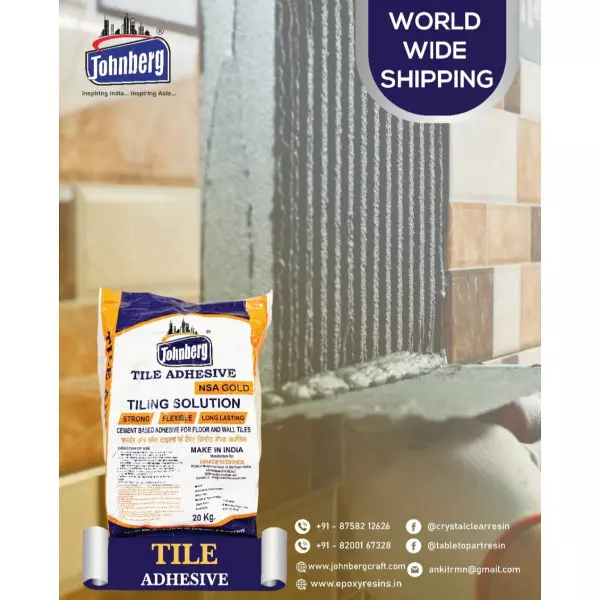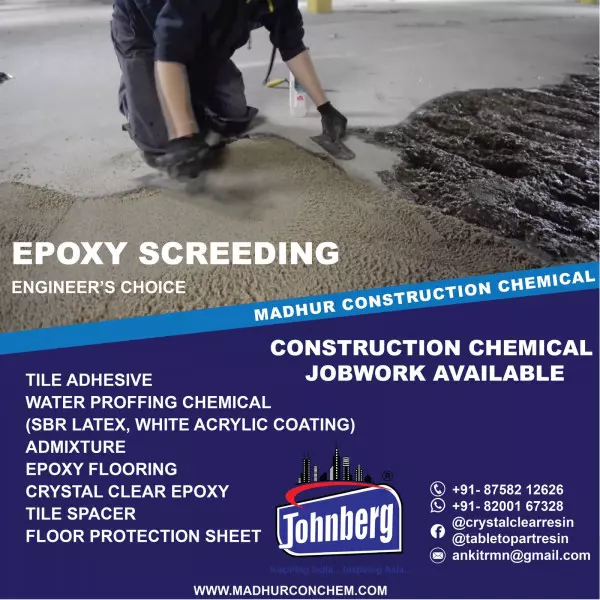- Home
- About Us
- Products
- Resin Furniture
- 3D Epoxy Flooring Service
- Resin Table Top
- Wooden Epoxy Resin Table Top
- Metallic Epoxy Flooring Service
- Conception Chemical Consultants
- Chemical Consultancy For Construction
- Construction Chemical Consultant
- Tile Grout
- Foundation Grout Consultant
- Paver Block Chemical Consultant
- Waterproofing Chemical Consultant
- Epoxy Pigment Consultant
- Heat Reflective Coating
- Water Repellent Coating
- Epoxy Grout
- Chemical Consultant
- Industrial Chemical
- Construction Chemical
- Epoxy Resin
- Epoxy Coating
- Polyester Resin
- Joint Sealants
- Cristal Clear Epoxy Resin And Hardner
- Construction Chemicals
- Polycarboxylate Ether And Liquid
- Solvent Cement
- Tile Protection Sheet
- Water Reducing Superplasticizer
- Epoxy Resin And Hardeners
- Two Component Waterproof Coating
- Epoxy Floor Coatings
- Casting Resin
- Sbr Latex Polymer
- Epoxy Grout Formulations
- Epoxy Resin Tabletops
- Tile Spacers
- Tile Levelling Spacers
- Industrial Night Vision Epoxy Grout
- Sbr Latex
- Johnberg Marble Polishing Liquid
- Acrylic Elastomeric Coating
- Weber Tile Adhesives
- Decorative Arts
- Resinic Crafts
- PU Flexible Tile Adhesive
- Resin Pressed Flowers
- Dry Pressed Flower
- Epoxy Putty
- Resin Furniture
- Services
- Updates
- Gallery
- Contact Us
Tile Grout Manufacturers In Ahmedabad
Details of Tile Grout
Tile grout is a construction material used to fill the gaps between tiles after they have been installed. It helps in binding the tiles together, preventing moisture from seeping underneath, and giving the tiled surface a finished and uniform look. Here's a detailed breakdown of tile grout:
Types of Tile Grout
Cement-Based Grout
Sanded Grout
Contains sand particles.
Ideal for joints wider than 1/8 inch (3 mm).
Offers strength and prevents cracking or shrinking.
Common in floors, walls, and exterior areas.
Unsanded Grout
Smooth and fine-textured (no sand).
For joints less than 1/8 inch.
Best for walls, vertical installations, and polished tiles (to avoid scratching).
Epoxy Grout
Made from epoxy resins and hardeners.
Very strong, stain-resistant, waterproof, and chemical-resistant.
Best for wet areas (like showers, pools, or commercial kitchens).
More expensive and harder to work with.
Furan Grout
Similar to epoxy but made with furfuryl alcohol.
Extremely chemical and heat-resistant.
Used in industrial settings (not common in residential applications).
Requires special handling and installation.
Pre-Mixed Grout
Ready to use out of the container.
Convenient for DIY projects.
Typically acrylic- or urethane-based.
Offers flexibility and water resistance.
Key Properties
Color Options: Available in many colors to match or contrast with tile.
Shrinkage: Low in quality grouts; excessive shrinkage can lead to cracks.
Water Resistance: Varies by type—epoxy is most resistant.
Ease of Cleaning: Epoxy and pre-mixed grouts are easier to clean than cement-based types.
Durability: Epoxy > Cement-based (sanded > unsanded).
Application Process
Preparation: Clean the tile joints thoroughly.
Mixing: For cement-based grout, mix with water or an additive.
Application: Use a rubber float to press grout into joints.
Cleaning Excess: Wipe off excess grout with a damp sponge.
Curing: Allow to dry for 24–72 hours, depending on type and environment.
Sealing (if needed): Cement-based grout should be sealed to prevent staining; epoxy generally doesn’t require sealing.
Common Issues
Cracking: Often due to movement, shrinkage, or improper installation.
Staining: Common in unsealed grout (especially light-colored).
Efflorescence: White powdery deposits caused by water carrying minerals to the surface.
Maintenance Tips
Seal cement-based grout periodically (every 1–2 years).
Clean regularly using a pH-neutral cleaner.
Avoid harsh chemicals that can degrade the grout.
Offered Product
Tile Grout
Usage/ApplicationTile JointPackaging TypePolythene BagFormPowderTypesVitrifiedTypeCement GroutPackaging Size1 Kg & 5 KgMaterialepoxyCategoriesCementitiousCategoryPolymer Modified GroutGradepremiumBrandJohnbergohnberg Brand Epoxy Grout For Tiles Grouting Application. High Strenght, Stain Proof, Easy To Use And Easy Ro Clean Application.... Read moreTile Grout In West Bengal
Tile Grout Is A Crucial Material Used In The Installation Of Tiles. It Fills The Spaces Between Tiles To Lock Them In Place, Prevent Moisture Penetration, And Provide A Finished Appearance. Here's A Detailed Overview:1. What Is Tile Grout?Grout Is A Mixture Of Cement, Sand, And Water (in Cementitious Grout), Or Resin-based In Epoxy Types, Used To Fill The Joints Between Tiles After They Are Laid.2. Types Of Tile GroutA. Cementitious GroutSanded GroutContains Fine Sand Particles.Use Continue
Tile Grout Service In Andhra Pradesh
Tile Grout Is A Construction Material Used To Fill The Spaces Between Tiles After They've Been Installed. It Not Only Improves The Overall Appearance Of A Tiled Surface But Also Helps Stabilize The Tiles And Prevent Moisture From Getting Underneath Them. Here's A Detailed Breakdown:1. Types Of Tile GroutA. Cement-Based GroutSanded Grout: Contains Fine Sand; Used For Joints Wider Than 1/8 Inch (3 Mm).Stronger, Prevents Cracking And Shrinking.Commonly Used For Floor Tiles.Unsanded Grou Continue
Tile Grout Manufacturer In Mizoram
Tile Grout DetailsTile Grout Is A Construction Material Used To Fill The Spaces Between Tiles After They Are Installed. It Helps In Bonding The Tiles Together And Prevents Dirt, Moisture, And Debris From Entering The Gaps. Grout Also Provides A Finished Look To The Tiled SurfaceEpoxy GroutResistant To Stains And Water. More Durable Than Cement Grout And Suitable For High-moisture Areas Like Bathrooms And Kitchens.Made From Polymers, Highly Resistant To Chemicals. Used In Industrial Setti Continue




